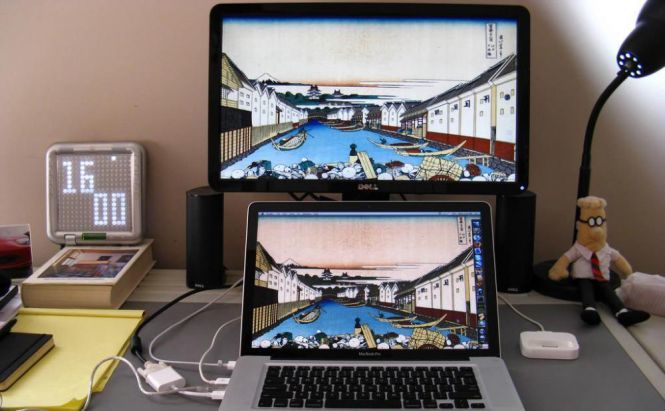 How to Connect External Displays to MacBook
How to Connect External Displays to MacBook
I'm sure any MacBook owner can think of numerous situations where an additional monitor would allow for great possibilities and help achieve desired goals faster and in a more comfortable way. Just look at the image on the left - isn't that a dream workspace? And even though connecting an external monitor is not that difficult, some may find it a bit confusing. And there certainly are some bumps on the road. (This article will not cover direct HDMI-HDMI connections which are available for some Macbook models and is pretty straightforward).
Can I Even?
You probably can. The main requirement (aside from the obvious - having a spare monitor) is having either a Mini DisplayPort or Thunderbolt on your MacBook. The confusion starts when people are trying to figure out what cables or adapters they need to have or purchase in order to connect a second monitor. Here's the gist: you have a MacBook with a port (MDP or Thunderbolt) and an external display with another port (HDMI, DVI, VGA), and your goal is to connect the two. This can be done via a direct cable connection or through the middleman (which is an adapter, like Moshi Mini DisplayPort to HDMI Adapter). An adapter is helpful when, for example, you already have an HDMI-HDMI cable for your monitor: you simply get an adapter like the one I linked to, then:
- Connect the adapter to your Mac via the Mini DisplayPort.
- Connect your HDMI cable to the adapter.
- Connect the other side of your HDMI cable to the display.
If you understand that part, then you won't find it difficult to figure out what is needed for your MacBook model.
Mini DisplayPort vs. Thunderbolt
 Thunderbolt vs. Mini DisplayPort. Picture credit: Apple
Thunderbolt vs. Mini DisplayPort. Picture credit: Apple
Don't be confused by these terms, in order to understand which port is on your MacBook - refer to the image on the right, and check out icons corresponding to MDP and Thunderbolt (the ports themselves look exactly alike). The only thing you need to know here, really, is that Thunderbolt is a newer technology that is backwards compatible with the older Mini DisplayPort. Basically, anyone who has Thunderbolt on his/her Mac can use Mini DisplayPort adapters without a problem. And for this very scenario (connecting an external monitor to our MacBook), the difference between the two doesn't really matter.
I Physically Connected Them, What's Next?
Well, you are almost there. Turn on both your MacBook and your monitor, and they should both be working. Next, go to System Preferences and click on the Display icon. On each screen, you will be able to control the resolution and arrangement of your monitors.
I hope you found this useful. It's really not as difficult as you might have imagined, give it a try if you haven't yet!




